Nutritional strategies for phosphorus management
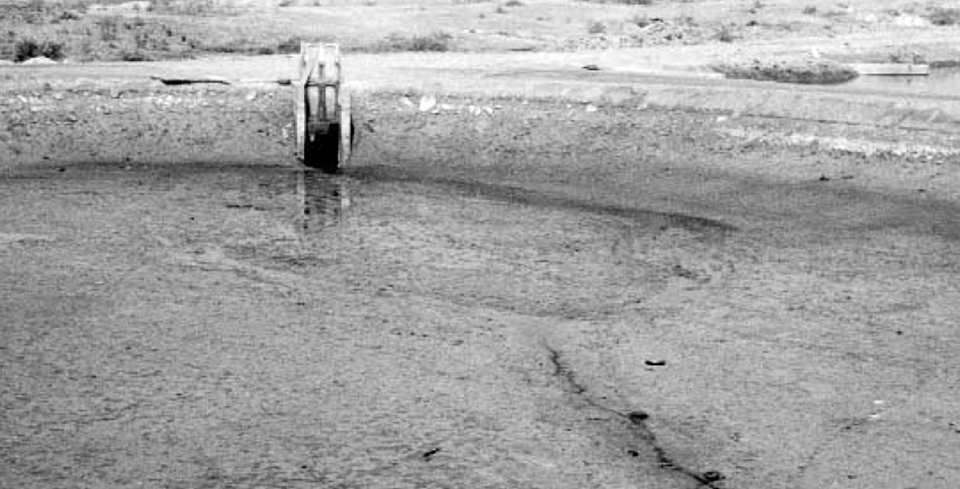
Shrimp have the ability to assimilate minerals directly from the aquatic environment. However, phosphorus is supplied in feed because its concentration in water is usually very low. In shrimp, phosphorus plays an important metabolic role and also serves as a pH regulator of intracellular and extracellular fluids. Structurally, phosphorus is mainly found associated with calcium in the exoskeleton.
Minimizing phosphorus in effluents
Phosphorus in effluent discharge waters from shrimp farms has been identified as a polluting agent to the environment. In addition, phosphorus build-up in the culture system can be detrimental, because it may favor the growth of unwanted algae and cyanobacteria.
Feeds are the vehicle for exogenous phosphorus in production systems. Thus, efforts should be directed to optimize dietary phosphorus levels and minimize phosphorus loading in the culture system, without inhibiting the survival and growth of shrimp.
Trial at Texas A&M
A 21-day experimental trial was conducted at the Shrimp Mariculture Research facility at Texas A&M University in Port Aransas, Texas, USA to test three dietary phosphorus levels (0.4, 0.8, and 1.2 percent with NaH2PO4 as the inorganic source of phosphorus), and three phosphate salts (NaH2PO4, Na2HPO4 and CaHPO4) at a dietary level of 0.8 percent.
Postlarval (PL) Litopenaeus vannamei shrimp of 0.9 mg mean initial weight were stocked at a density of 1.5 PL per liter in an indoor system with constant aeration and no water exchange. Water temperature was maintained at 27 to 29 degrees-C, and salinity was maintained at 23 to 25 ppt.
Total reactive phosphorus was measured at the end of the trial. Data obtained from this completely randomized design with seven replicates per treatment were statistically analyzed to determine significant differences among treatment means.
Survival and growth
PL survival was over 81 percent for all treatments. Growth of postlarvae fed diets with different phosphorus levels was not significantly different (Fig. 1).
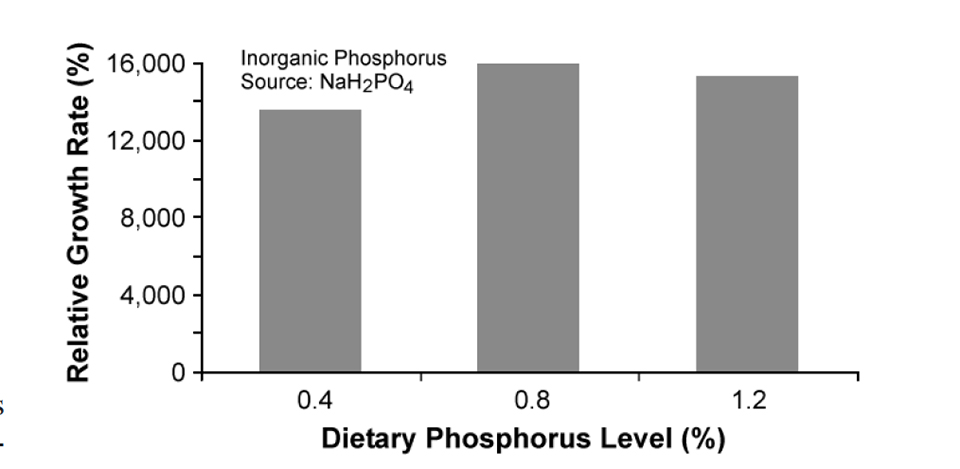
Total reactive phosphorus accumulation
However, total reactive phosphorus accumulation in the water significantly increased with higher phosphorus levels (Fig. 2). Again, PL growth was consistent, regardless of phosphate salt used in the diet (Fig. 3). But phosphorus accumulation was significantly lower with the diet supplemented with CaHPO4 compared to the diets containing dibasic or monobasic forms of sodium phosphate (Fig. 4).
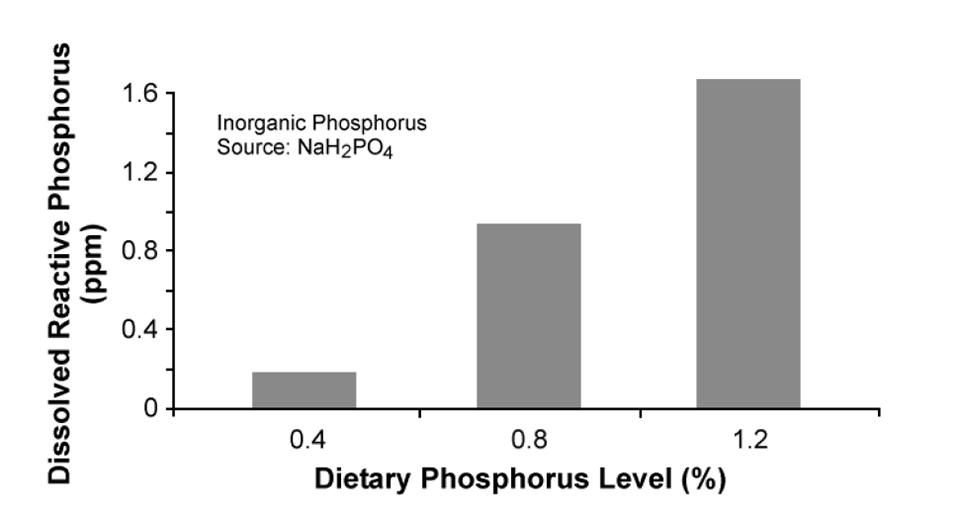
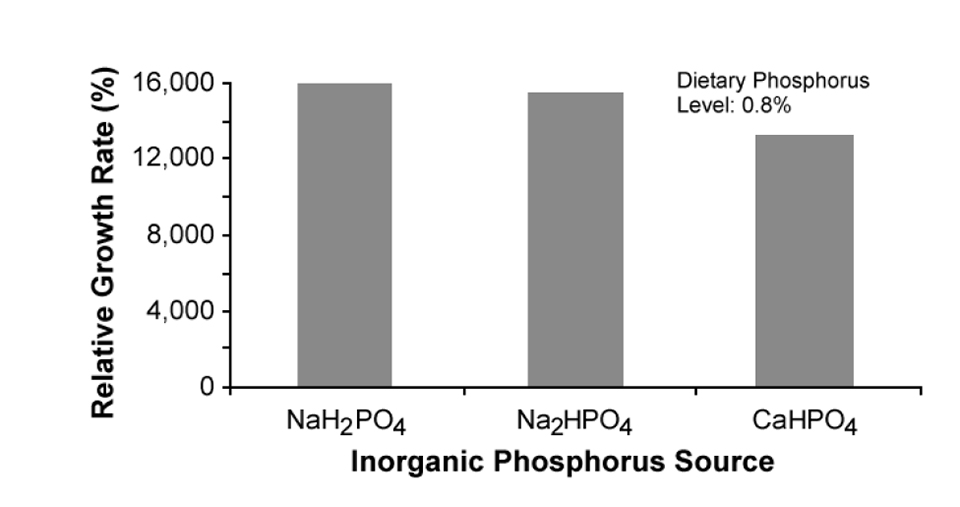
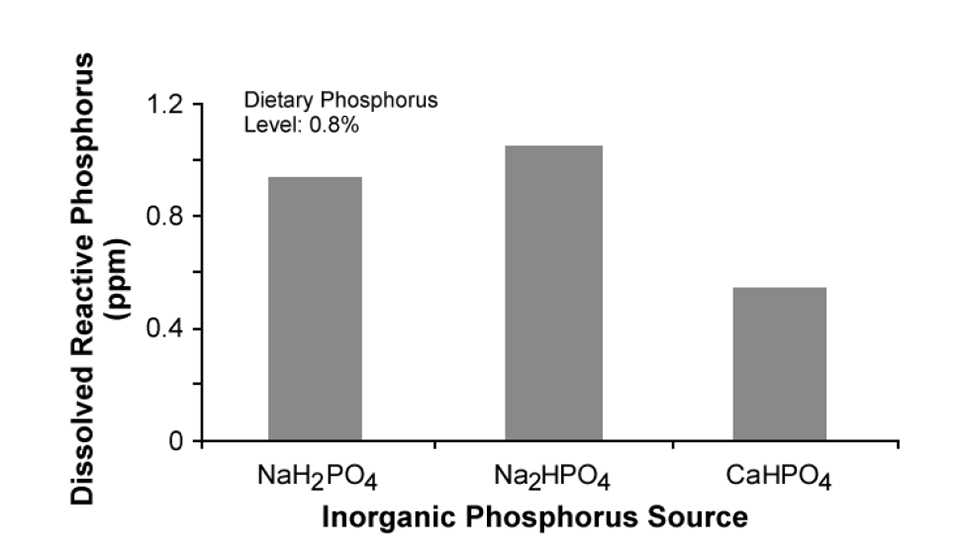
FCR
Feed-conversion ratios ranged 1.1-0.9.
Nitrogen
Mean concentrations of total ammonia-nitrogen and nitrite-nitrogen were 0.25 (pH = 7.9) and 2.1 milligram per liter, respectively.
Phosphorus
Mass balance analysis of phosphorus (Table 1) indicated that as the dietary phosphorus level decreased, percent phosphorus retention in shrimp tissue increased. Consequently, less phosphorus ended up in the water.
Velasco, Mass balance analysis of phosphorus, Table 1
| Phosphorus Source | Dietary Level (%) | Feed (mg P) | PL (mg P) | Net P Retention (%) |
|---|
Phosphorus Source | Dietary Level (%) | Feed (mg P) | PL (mg P) | Net P Retention (%) |
|---|---|---|---|---|
| CaHPO4 | 0.8 | 26.4 | 9.4 | 35.3 |
| Na2HPO4 | 0.8 | 26.4 | 11.4 | 42.9 |
| NaH2PO4 | 0.8 | 26.4 | 11.3 | 42.5 |
| NaH2PO4 | 0.4 | 14.1 | 9.3 | 65.1 |
| NaH2PO4 | 1.2 | 38.6 | 11.0 | 28.3 |
Conclusion
Results from this research in a culture system without water exchange indicated that biological performance of postlarvae was similar regardless of varied dietary phosphorus level or inorganic phosphorus source. However, these factors greatly influenced total reactive phosphorus accumulation in the water.
Thus, careful consideration should be given to phosphorus levels and phosphorus sources when formulating aquatic feeds. These should be selected in terms of shrimp biological performance, cost, availability and environmental impact on the culture water.
(Editor’s Note: This article was originally published in the December 2001 print edition of the Global Aquaculture Advocate.)
Now that you've finished reading the article ...
… we hope you’ll consider supporting our mission to document the evolution of the global aquaculture industry and share our vast network of contributors’ expansive knowledge every week.
By becoming a Global Seafood Alliance member, you’re ensuring that all of the pre-competitive work we do through member benefits, resources and events can continue. Individual membership costs just $50 a year. GSA individual and corporate members receive complimentary access to a series of GOAL virtual events beginning in April. Join now.
Not a GSA member? Join us.
Authors
-
-
Addison Lawrence, Ph.D.
Shrimp Mariculture Research
Port Aransas, Texas, USA
Tagged With
Related Posts

Responsibility
Carbon-nitrogen ratios in pond fertilization and biofloc systems
Prof. Claude Boyd on the importance of carbon-nitrogen ratios for pond fertilization and biofloc systems, and the relevance of precise carbohydrate inputs.

Health & Welfare
Managing natural productivity in channel catfish nursery ponds
Decisions on stocking channel catfish fry should be based on the abundance of large zooplankton in the pond water, rather than total zooplankton abundance.

Responsibility
Greening the blue revolution
The worldwide adoption of ecologically, socially and economically sound systems based on a series of principles of organic agriculture is exemplary if unrealistic.

Responsibility
Thoughts on pond fertilization
Prof. Boyd provides additional insights into fertilization of aquaculture ponds, discussing phytoplankton requirements, organic and inorganic fertilizers, and other relevant aspects of pond management.


